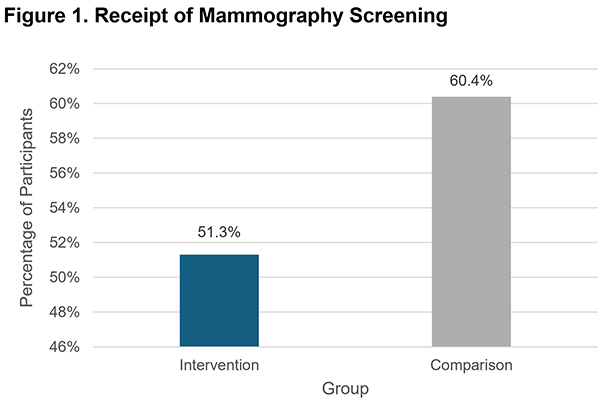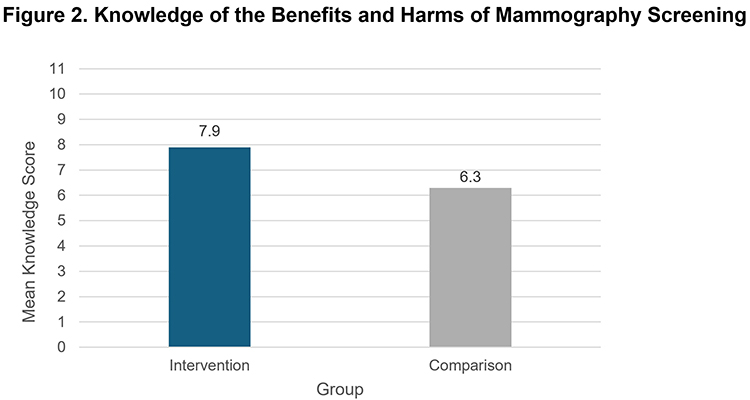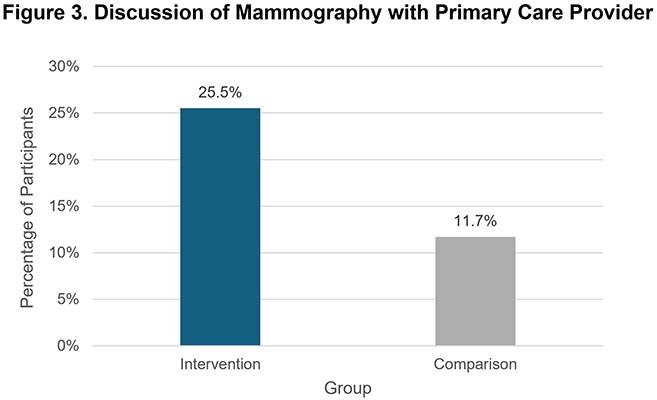The Implementation Guide is a resource for implementing this evidence-based program. It provides important information about the staffing and functions necessary for administering this program in the user’s setting. Additionally, the steps needed to carry out the program, relevant program materials, and information for evaluating the program are included. The Implementation Guide can be viewed and downloaded on the Program Materials page.
Program Synopsis
Designed to enhance decision-making around mammography screening and reduce over-screening among women aged 75 years and older, this intervention is a decision aid that helps women weigh the potential benefits and harms of screening—particularly important given that current guidelines do not make a recommendation for or against screening in this age group due to insufficient evidence. The study demonstrated lower rates of mammography use, suggesting the tool may support more individualized and informed decision-making.
Program Highlights
Program Materials
Preview and order the materials from the developer
Implementation Guide
Download Implementation Guide
Program Scores
The Need
According to 2024 estimates, there are more than 300,000 new cases of breast cancer per year. For women aged 40 to 74 years, the U.S. Preventive Services Task Force (USPSTF) recommends biennial screening mammography. However, for women 75 years or older, USPSTF does not make a recommendation for or against screening mammography given the insufficient evidence to assess the balance of benefits and harms for this age group. As women age and their life expectancy decreases, the potential for over-diagnosis and over-treatment from mammography must be considered. Additionally, some breast cancers found through screening in older women may be slow growing and unlikely to cause harm in their lifetime.
Interventions are needed to inform older women of the benefits and harms of mammography, help them make an informed decision about screening, and reduce over-screening for this age group.
The Program
The Mammography Decision Aid for Women 75 and Older is a tool designed to enhance decision-making around mammography screening and reduce over-screening among older women. Based on the Ottawa Decision Support Framework, the decision aid informs older women of the potential benefits and harms of mammography screening. It offers information on breast cancer risk factors for women 75 years and older, health and life expectancy, likely outcomes for women who are screened or not screened with mammography, competing mortality risks, and breast cancer treatment options. It also includes a health score calculator and a values clarification questionnaire to help women weigh the benefits and risks of screening. Lastly, the decision aid includes a question about their intention to be screened and encouragement to discuss mammography screening with their primary care provider (PCP).
The decision aid is provided to women to complete prior to a visit with their PCP. There are two versions of the decision aid, one for women aged 75 to 84 and another for women aged 85 and older. They are largely the same, but the messages are tailored to the age groups to take life expectancy into account.
The decision aid is available in English and Spanish.
Community Preventive Services Task Force Finding
 This program uses an intervention approach recommended by the Community Preventive Services Task Force: one-on-one education interventions (Breast Cancer Screening).
This program uses an intervention approach recommended by the Community Preventive Services Task Force: one-on-one education interventions (Breast Cancer Screening).
Time Required
-- Variable time is required to set up an automated process in the electronic health record system (e.g., to identify patients who would benefit from using the decision aid and deliver the decision aid via the patient portal)
-- About 5 to 10 minutes for participants to complete the decision aid
-- Time for the PCP to discuss mammography screening with their patient
Intended Audience
The intended audience for the program is women aged 75 and older.
Suitable Settings
The program is suitable for implementation in the home and in clinical settings.
Required Resources
Required resources to implement the program include the following:
-- Decision aid for women 75 to 84 (English version)
-- Decision aid for women 85 and older (English version)
-- Decision aid for women 75 to 84 (Spanish version)
-- Decision aid for women 85 and older (Spanish version)
For costs associated with this program, click on Contact the Program Developer on the Program Materials page.
About the Study
In a cluster randomized controlled trial, 137 PCPs in Massachusetts (n=96) and North Carolina (n=41) were randomly assigned to the intervention group (n=67) or to the comparison group (n=70). The intervention group (n=283 participants) received the decision aid, and the comparison group (n=263 participants) received the American Geriatrics Society Health in Aging Foundation’s home safety pamphlet.
Patients were eligible to participate if they were English-speaking women aged 75 to 89 years who were scheduled for a routine visit or physical examination with their PCP in the next 4 to 12 weeks at the time of recruitment. They had to have obtained a mammography in the past 2 years but not the past 6 months. Women were excluded from the study if they had invasive or noninvasive breast cancer or atypia, dementia or other issues with mental capacity, or less than a seventh-grade education. They were also excluded if they had stopped participating in screening, were having their first visit with the PCP, or were not seeing their PCP during the study.
The average age of participants was 79.8 years old; 78% were White, 18% were Black, less than 2% were Hispanic, and less than 2% were “other.”
The primary outcomes were receipt of mammography within 18 months of follow-up, knowledge of the potential benefits and harms of mammography, and a documented discussion about mammography with a PCP. Receipt of mammography within 18 months of follow-up was assessed by reviewing electronic medical record notes, radiology records, and screening sheets (records of mammograms performed outside the medical system) and contacting the patient if needed. Knowledge of the potential benefits and harms of mammography was assessed immediately after the PCP visit using an 11-item tool with true/false and multiple-choice questions. Responses were scored on an 11-point scale, with a higher score representing greater knowledge. PCP notes were reviewed 6 months after the PCP visit to determine if PCPs documented a discussion with the patient about mammography.
Key Findings

- Within 18 months of the intervention, a lower proportion of intervention group participants than comparison group participants had received mammography screening (p=.006).

- At post-intervention, intervention group participants had greater knowledge of the benefits and harms of mammography screening than did comparison group participants [adjusted mean risk difference at 95% CI=1.6 (1.3 to 1.9)].

- Within 6 months of the intervention, a higher proportion of intervention group participants than comparison group participants had a documented discussion about mammography with their primary care provider [adjusted risk ratio at 95% CI=2.17 (1.39 to 3.40)].


